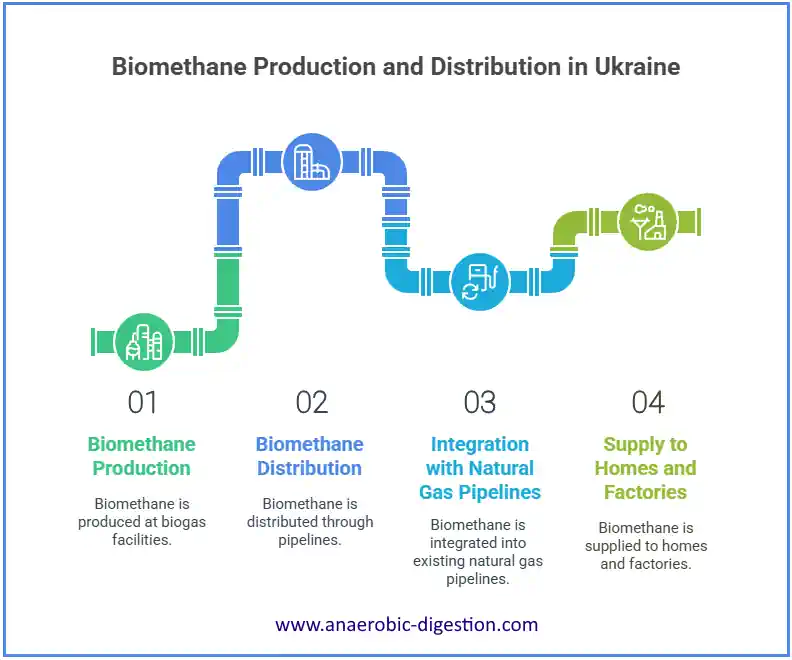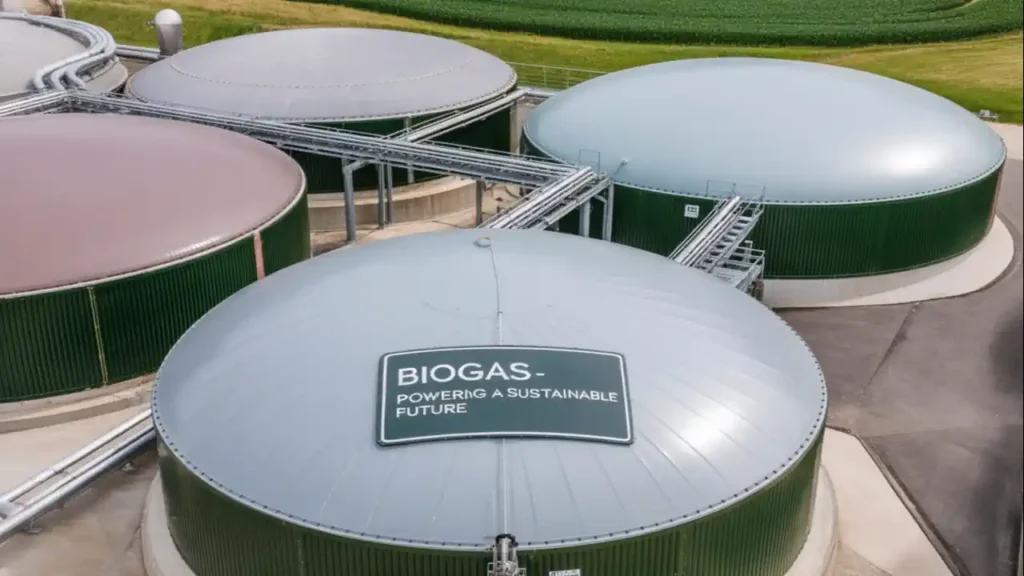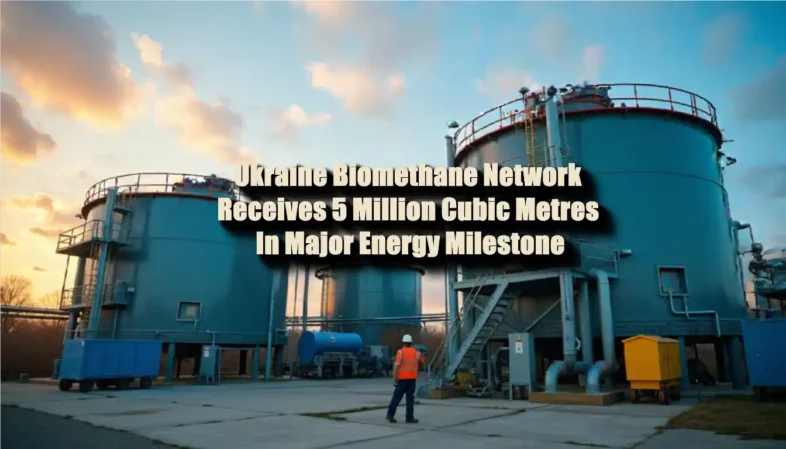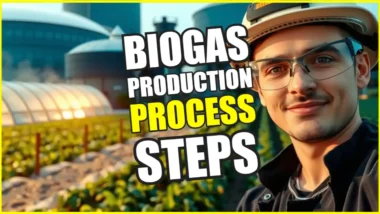Getting enough clean energy is a big challenge, especially as many look for safer and greener ways to reduce the use of fossil fuels. Many countries want to cut greenhouse gas emissions and meet climate goals, but progress can feel slow or out of reach.
The Ukraine Biomethane network just took a real step forward in renewable energy.
Since September 2024, Ukrainian biomethane producers have delivered over five million cubic metres into the national gas transmission system. This success boosts green energy supplies and offers new hope for those aiming at carbon neutrality.
This blog will explain what this milestone means for Ukraine's energy independence, its natural gas market, and plans to join the wider EU biomethane market. Continue reading if you want to learn how Ukraine Biomethane is making waves in Europe's shift to sustainable development.
You'll want to see what's coming next!
Key Takeaways
- Since September 2024, Ukraine's biomethane producers have delivered over five million cubic metres into the national gas transmission system.
- Kateryna Kovalenko from GTSOU announced this marks a “major breakthrough” for renewable energy and supports exports as well as energy independence.
- The Ministry of Energy built strong rules for biomethane since 2022, helping plants like Vitagro Group meet EU standards and supply the network.
- Two Ukrainian producers have now started exporting biomethane to several European countries after successful test deliveries at the Ukrainian-Slovak border.
- Ukraine plans to connect its Gas Transmission System Operator to the EU Union Database, following a February 2023 memorandum with the EU on green gases like biomethane and hydrogen.

The Achievement of 5 Million Cubic Metres of Biomethane
Ukraine's energy industry marked a huge step with the production then distribution of five million cubic metres of sustainable biomethane. This progress signals real promise, showing that Ukrainian biogas sites and natural gas pipelines can link up to create reliable renewable resources for both homes and factories.
Announcement by Kateryna Kovalenko
Kateryna Kovalenko, Head of the Strategy Department at the Gas Transmission System Operator of Ukraine (GTSOU), shared big news during a recent biomethane conference. She reported that Ukrainian biomethane producers had supplied 5 million cubic metres into the gas transmission network.
This figure marks a key milestone for Ukraine's renewable energy journey and drives momentum in sustainable biomethane adoption.
Kovalenko stressed that this progress supports both energy independence and export goals, framing it as a major breakthrough for renewable gas.
Her message echoed growing interest from foreign investors who want to help modernise energy infrastructure and support Ukraine's shift away from Russian gas. With more plants integrating organic waste from farms using technologies like anaerobic digestion, these achievements strengthen regulatory frameworks while building trust in clean biofuels within Ukraine's agricultural sector.
Direct involvement with clusters such as biogas plants near Khmelnitsky shows how local production now fits global climate goals set by the European Union.
Ministry of Energy's role in development
The Ministry of Energy of Ukraine has set the pace for renewable gas by building a clear regulatory framework. Their work covers every step, from biomethane production to its certification and eventual export.
Since 2022, strict rules have helped local companies like Vitagro Group launch new biomethane plants. These moves keep Ukrainian biomethane in line with EU standards and support energy independence goals.
Energy officials coordinate all technical procedures with GTS operators, storage firms, and distribution networks each key to smooth flow into both domestic pipelines and European markets.
My contacts among plant managers say this guidance made it possible to test deliver green gas right up to the Ukrainian-Slovak border without setbacks or confusion over compliance.
With help from state bodies, producers now handle carbon emission prices more easily while boosting both agricultural sector income and sustainability.
Ministry efforts also reach foreign investors searching for stable markets in renewable energy sources like solid biomass or organic waste conversion. State support attracts R&D funding that improves technology for district heating using sustainable biomethane or even lignocellulosic materials as feedstocks; these steps secure climate neutrality targets set out by the European Commission.

Ukraine's energy sector modernisation goals
Ukraine aims to modernise its energy sector. The country wants to create new markets and join European energy systems. This goal aligns with Ukraine's vision for energy independence.
Mykola Kolisnyk, the Deputy Minister of Energy, states this will help maintain agricultural competitiveness too.
Key steps include improving biomethane production and connecting to the gas transportation system (GTS). Ukraine focuses on renewable energy sources like biomethane from organic waste.
They plan a smooth integration into the EU biomethane market as part of their strategy for sustainable energy. Collaboration with stakeholders is vital in this effort, setting up pathways for green energy use throughout Europe.
Next, we will examine how they plan to integrate and export biomethane efficiently.
Integration and Export of Biomethane
Ukraine is set to connect biomethane producers to the national gas system. This will allow for exports of sustainable gas to European countries, boosting energy security and independence.
Method of connecting producers to the GTS
Producers of biomethane connect through the gas distribution network, known as GDN. This method does not stop them from exporting their biomethane to other countries. It allows producers to send sustainable energy directly into the Gas Transmission System (GTS).
Kateryna Kovalenko announced this achievement as a major step forward for Ukraineâs renewable energy industry. The Ministry of Energy plays an important role in this development, guiding producers on how to integrate their biomethane plants into existing networks.
This connection supports Ukraine's goals for modernising its energy sector and achieving energy independence. Foreign investors see potential here as they engage with Ukrainian businesses in renewable gas production.
As the country moves towards carbon neutrality, these connections are vital for meeting climate goals while also optimising agricultural areas that produce organic waste.
Exporting biomethane to European countries
Ukraine's biomethane production is making strides. The successful integration of over 5 million cubic metres into the gas transmission system (GTS) paves the way for exciting exports.
- Two producers have begun exporting biomethane to several European countries. This step marks a new chapter in Ukraine's energy independence journey.
- The gas transmission system allows for smooth connections between producers and markets. It opens doors for broader access to renewable energy sources.
- Ukraine aims to strengthen its place in the EU biomethane market. This will help meet climate goals and carbon neutrality targets.
- Biomethane exports support sustainable energy practices by using organic waste effectively. This process reduces greenhouse gas emissions from landfills.
- Exporting biomethane presents opportunities for foreign investors interested in the agricultural sector. Increased production can boost agricultural output while providing animal feed and organic fertiliser.
- Test deliveries have started at the Ukrainian-Slovak border, showing the practical side of this initiative. Successful trials could lead to larger agreements with European partners.
- The Ministry of Energy plays a crucial role in coordinating these efforts, ensuring compliance with EU standards. Their involvement strengthens Ukraine's regulatory framework for renewable fuels.
- Each export promotes environmental benefits and contributes to decarbonisation goals across Europe, fostering collaboration between nations.
These steps are crucial as Ukraine integrates further with European Union standards and prepares for strategic partnerships ahead.
Development of Biomethane Production Clusters
Biomethane production clusters are growing in Ukraine. Experts from the agricultural sector and energy technology fields are working together. They focus on using organic waste to create sustainable biomethane.
This teamwork helps make gas networks more efficient and connects farmers with biogas plants.
Collaboration with key stakeholders
The development of biomethane production clusters involves crucial partnerships with key stakeholders like GTSOU and gas transmission operators. These groups are working together to optimise the gas networks in Ukraine.
This collaboration ensures that producers can easily connect to the Gas Transmission System (GTS).
Such teamwork supports Ukraine's goal of energy independence and sustainability. It also creates opportunities for exporting sustainable biomethane. As these connections grow stronger, they enhance Ukraine's position in the European Union biomethane market, helping to meet climate goals and reduce carbon emissions from natural gas.
Optimisation of gas networks
Collaboration with key stakeholders leads to real progress. Optimising gas networks helps Ukraine's biomethane sector grow. This work focuses on improving areas that currently have limited transmission capacities.
The production clusters will be based on zoning. These zones will allow for better management of resources and more efficient transportation of biomethane. By working together, local producers can connect easily to the Gas Transmission System (GTS).
This connection opens doors for exporting biomethane across borders. With support from foreign investors, Ukraine can integrate into the EU biomethane market smoothly. The goal is clear: enhance energy independence and meet climate goals while reducing greenhouse gas emissions in the process.
Integration with European Union Standards
Ukraine prepares to meet European Union standards for biomethane. This will help connect its energy systems to the EU database and strengthen ties with European partners.
Preparation to connect to the European Union Database
Ukraine is preparing to link its Gas Transmission System (GTS) Operator to the European Union Database (UDB). This connection is essential for Ukrainian producers. It will help them qualify for green premiums in the European Union biomethane market.
Kateryna Kovalenko, a key figure in this development, has highlighted its importance.
The UDB integration plays a crucial role in energy independence and sustainable growth. It allows local biomethane production from organic waste to align with European standards. Foreign investors are keenly watching these developments as Ukraine strives for carbon neutrality and decarbonised energy solutions.
Memorandum of Strategic Partnership with the EU
A Memorandum of Strategic Partnership was signed in February 2023. This agreement aims to boost cooperation between Ukraine and the EU. The focus is on areas like biomethane, hydrogen, and other renewable gases.
Both sides want to enhance their energy independence through this partnership.
The memorandum helps set a framework for developing the biomethane sector in Ukraine. It encourages foreign investors to get involved. By aligning with European standards, Ukraine prepares for integration into the EU biomethane market.
This step is vital for achieving carbon neutrality goals while supporting sustainable energy production from organic waste.

Conclusion
Ukraine's biomethane network has hit a big milestone. It now integrates over 5 million cubic meters of biomethane into its gas system. This achievement shows the country's push for energy independence and modernisation.
With strong support from the Ministry of Energy, Ukraine is building new markets and partnerships in Europe. These steps will help strengthen both the economy and sustainable energy goals for the future.
FAQs
1. What is the significance of Ukraineâs biomethane network receiving 5 million cubic metres?
This milestone marks a major step for renewable energy in Ukraine. It highlights progress in sustainable biomethane production, supporting energy independence and the countryâs transition away from natural gas.
2. Who are the key players involved in this achievement?
The Vitagro Group led efforts at their biomethane plant, with support from foreign investors and oversight by Ukrainian authorities. The European Commission also monitors regulatory framework development to ensure compliance with EU standards.
3. How does biomethane export impact Ukraine's agricultural sector?
Biomethane production uses organic waste from farming and animal husbandry, reducing greenhouse gas emissions while offering new income streams for farmers. This supports both organic farming and efficient waste disposal across agricultural production.
4. Why is access to the EU biomethane market important for Ukraine?
Selling into the EU market opens doors for Ukrainian exports beyond local demand, especially after test delivery at the Ukrainian-Slovak border proved successful. This boosts green energy revenues while aligning with Europeâs climate goals on carbon neutrality.
5. What environmental benefits come from expanding sustainable energy like biomethane?
Producing renewable gas helps lower carbon emission prices and reduces reliance on oil & gas imports during peak load periods or crisis events such as the Russian invasion. Biomethane also advances targets set under global renewables agreements to fight the climate crisis.
6. How do regulations shape the future growth of Ukraine's renewable gas industry?
A strict regulatory framework ensures safety, traceability through systems like Union Database (UDB), fair state subsidies allocation, and clear user profiles for electricity generated using renewable sources; these steps attract S&P Global Sustainable1 ratings plus further investment tracked by S&P Capital IQ toolsâdriving ongoing momentum towards a cleaner economy reliant on sustainable energy solutions rather than fossil fuels or outdated internet infrastructure models alone.





